
Title means "Quietness", "Comfortable Sound" and "Excellent Acoustics"
Nagata Acoustics News 04-02 (No.194)
Issued : February 25, 2004
"Premiere Shisui" Cultural Hall Opens
by Toshiko Fukuchi
On Saturday, September 13, 2003, Shisui Town's newly built "Premiere Shisui" cultural facility (comprising a hall and a municipal public library) held its inaugural concert, featuring a performance by New Philharmonic Orchestra Chiba. Shisui Town is a modest-sized community located adjacent to Narita City in the northern part of Chiba Prefecture. Visitors can reach Shisui in a little more than an hour from downtown Tokyo by taking the Narita Airport-bound express train from Tokyo Station.
<< The Origin of Shisui Town's Name >>
The three Chinese characters used to write Shisui Town's name literally mean "sake" + "sake" +well (the kind of well from which water is drawn). According to Shisui Town's website, this name originated in a legend about the devoted son of a man who enjoyed drinking "sake". The son worked very hard to earn money to buy "sake" for his father, but when his wages turned out to be insufficient, he went to a well to draw water instead, and the liquid he raised from the well was the"sake" he desired for his father. Because of this legend, the name of Shisui is written with the character for "sake", plus the character for "sake" repeated, then the character for "well."
In keeping with the town's name, Shisui boasts a 300-year-old "sake" brewery's storage house. The building has been turned into a historical museum that, in addition to preserving the history of the town's breweries, also serves visitors a sample taste of "sake" as well.
<< A Small, Well-equipped Hall and Library >>
Entrance Hall
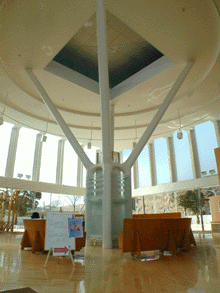 |
The new cultural facility, Premiere Shisui, is comprised of a 350-seat, small-scale hall outfitted with a full complement of stage equipment and a library. Central to the facility's layout is its entrance hall, which is flanked on its right by the performance hall and on its left by the library. The entrance hall's ceiling is two stories high and the upper walls of this space are a series of glass panels that bring natural sunlight into the room by day and make the starry sky visible at night, creating an attractive and pleasant space. On both sides of a central, architectural column, lounge chairs and an internet corner have been installed so that, when the entrance hall is not in use as the performance hall's pre-concert and intermission foyer, the entrance hall space doubles as a welcoming destination where the community, from youngsters to seniors, can find a place to sit or something to do.
Azusa Sekkei Group served as the project's architect. Kajima Corporation built the facility.
<< The Performance Hall's Configuration and Interior >>
Multiple curved panels finished with wood veneer form the side walls of the performance hall. Overhead, above the audience seating, white fabric is fastened into concave-hanging rows to create the hall's ceiling. Overall, the hall has a warm ambience.
Because this hall is small in size, I began my acoustical design work on this project with the knowledge that, in order to have the side walls and ceiling generate the graceful sound reflections desired, the side walls and ceiling would need to incorporate three-dimensional architectural elements that propagate sound diffusion. The architect assigned to the project by Azusa Sekkei Group is someone with whom I have worked on a number of other hall projects and it seems that my acoustical design approach is now well understood, because when we met the first time to review the architectural plans, they already contained a good rough estimate of the shapes needed to ensure sound diffusion.
The construction of the hall's ceiling began with the installation of a drywall ceiling. Then, below this ceiling, thick fabric of the type used for air domes was stretched tautly into place using wires to fasten the fabric according to the architectural design's concave shapes. During the planning phase of the project, I had provided the requirement that the ceiling be sound reflecting, and when I tested a mock installation of the fabric ceiling during the construction phase, I confirmed that for mid-range sound the fabric ceiling satisfies this requirement. The wall behind the audience seating features an openwork design with the appearance of stacked wood blocks. Behind this openwork wall, we installed glass wool to meet my requirement that this wall be a sound-absorbing surface. This wall is the only sound-absorbing element of the hall's acoustical room design. When the stage's sound reflecting acoustical shell is in place, the hall's reverberation time is 1.3 seconds (at 500 Hz, with the hall unoccupied).
<< The Stage's Acoustical Shell >>
View from audience
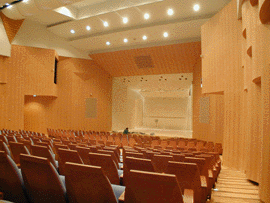 |
In keeping with the hall's official designation as a hall for cultural activities, the project's programming required that regardless of the hall's small size, the hall should be a multipurpose hall equally capable of being used for classical music concerts, cinema, symposia and other events. In order to adapt the stage for concerts of classical music, we designed a removable acoustical shell.
<< The Stage's Acoustical Shell >>
The usual drawback of acoustical shells is that they require considerable manual labor and hours of set-up time. But the acoustical shell of Premiere Shisui's hall can be installed with the easy flip of a single switch. Credit for the idea that led to this innovative acoustical shell design goes to the project architect, Mr. Nagaike, of Azusa Sekkei Group, who has participated in the architectural planning and design for many hall projects. Since a modest-sized hall like Premiere Shisui, located in a non-urban setting, would be hard-pressed to employ a full-time stage technician, having an acoustical shell that can be easily set up or stored away by a single person in less than 30 minutes is a greatly appreciated mechanism.
For the proscenium's design, I chose a method that enables the height of the proscenium to adapt to the needs of the performance. When the acoustical shell is used, the proscenium's high opening is in full view and meets the ceiling to form a smooth and continuous transition. When the stage is set up with a stage curtain, a valance curtain lowers the height of the proscenium opening.
As can be seen in the accompanying photo, we chose a curved design for the shape of the acoustical shell. This design choice matches the curved, diffusion-propagating shapes of the audience side walls, and, like the smooth transition from the top of the proscenium to the hall's ceiling, the curved acoustical shell also answers the acoustical design need for smooth continuity from the shell to the hall's fixed interior surfaces.
<< Overflow Attendance at the Inaugural Concert >>
View from stage
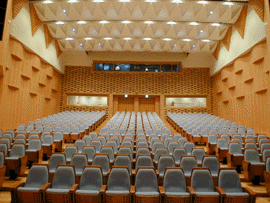 |
To fill the hall for the inaugural concert, Premiere Shisui planned to give away free tickets to the public on a first-come-first-served basis, starting on a specific date two weeks before the concert was to be performed. However, an overwhelming number of people turned out for the complimentary tickets, so the hall quickly responded by adding another layer to the opening-concert's audience selection process. On opening day, the hall held a lottery to determine who would be lucky enough to attend the hall's first concert. This vignette from the hall's opening preparations captures the exuberance and enthusiasm of Shisui Town's residents for their new hall.
The inaugural concert's program featured a range of standard works that even people not too familiar with classical music have heard at least once before, including famous arias and Japanese songs. The program of easy-listening music was also enjoyed by many people who were unsuccessful in obtaining a ticket for a seat in the hall, but remained in the hall's foyer and the building's entrance hall throughout the concert and listened over the loudspeakers in these areas.
I, too, was one of the people who went to the hall on opening day to attend the inaugural concert, but was unable to get a ticket. Instead, I attended a rehearsal held earlier in the day.
Basing my post-completion evaluation on this rehearsal, I can report that even with the stage holding a 25-person, maximum-capacity performing configuration of an orchestra plus men's and women's choirs, the performance had masterful clarity and well-balanced, graceful acoustics. In my opinion, one of the key success factors here is the auditorium's relatively high ceiling height respective to the overall size of the room. The opening concert's performers shared with me that they were able to perform with ease on the hall's stage and they made favorable comments about the hall's atmosphere.
I am told that this hall does not have plans to produce any in-house programming, so we must look to the local community's enthusiasm to connect the hall's popular start with a hopefully equally well-attended and popular future. I look forward to Premier Shisui having a calendar with numerous and varied events.
Sensing, Verbalizing What We Sense and Quantification Trends
-- Comments on the use of numbers to evaluate a hall's acoustics --
by Dr. Minoru Nagata
Today, even our world of subjective sensations has become the target of the drive to describe by quantifying. The first step towards quantifying sensory experience is to precisely express in words what our five senses experience. This is not an easy thing to do.
There is a long-established practice for environmental noise measurement that calculates noise levels by weighting the SPL, which is a physical quantity, with the frequency response curve of human ears. This is an internationally accepted gauge. However, this ability to use a simple method to quantify how loud or soft we perceive sounds to be, and our use of a simple calculation to arrive at the measurement, is surely a rarity in the world of sensory perception. One other example of such facile calculation is the method of measuring temperature and humidity to arrive at a numeric value for how comfortable our bodies feel in specific weather conditions.
It is worth noting that measuring a phenomenon such as noise level has as its primary input a larger or smaller amount of energy, so the mechanism that produces it can be considered simple. But if we consider, instead, for the phenomenon of sound quality, the mechanism is not simple.
<< Words to Describe Sound Quality >>
Some years ago, during the audio equipment industry's heyday, sound quality was a much-debated topic, with the discussion centered especially on the sound quality of loudspeakers. A plethora of expressive terms were bandied about, and they stoked the excitement of audiophiles. At least some of the expressions then in vogue, for example, "warmth," "crispness" and "transparency," have bases in measurable physical properties, but some of the terms used, such as "musical" and "granularity," reflected value judgments based purely on subjective impressions.
Now, however, that audio equipment has achieved today's sustained high performance standards, audio magazines no longer rate and rank loudspeakers and other audio gear based on elusive dimensions of sound quality. Rather, the choice of language is now left to a cadre of discerning audio equipment critics who write about high-performance audio equipment with words that are appropriate to their topics.
<< Charting Our Sense of Taste into Quadrants >>
Coffee Flavor Chart
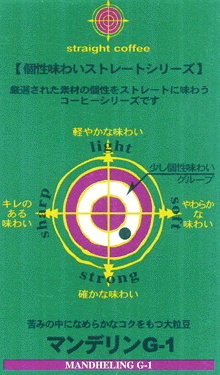 |
Currently, the evaluation methodology formerly applied to audio equipment seems to be in fashion in publications about wine, sake and coffee, where it is used to evaluate flavor. The accompanying photo shows a chart that a local Tokyo coffee house keeps handy for customers' reference and which has two dimensions, one measuring the degree of flavor from light to strong, and the other dimension measuring the degree of flavor from soft to sharp. Together, the two dimensions create four quadrants. It seems to me that of all the words we have for describing sensory experience, the lexicon of words to describe the flavors we taste is probably the most developed. We are better at communicating and sharing meaning about how things taste than we are at communicating about our other sensory experiences.
<< Finding Words to Describe How a Room "Sounds" >>
As for descriptive words to capture how a room sounds, this is even more complex and ambiguous than trying to describe audio equipment's "sound quality." Nevertheless, there are members of acoustical academia and professional circles who are now proposing that a certain set of physical properties, known as sound field parameters, account for the characteristics of a room's sound. However, sound field parameters are evaluated and tested in laboratories, and a distinction must be made between results obtained in a test environment and the perceived acoustical effects that an audience experiences during a concert in a concert hall. That is, the particular sound characteristics we experience when we attend concerts at different halls, and even the differences we perceive between what we hear in a first-floor seat and a balcony seat in the same hall may or may not be fully explainable using the current set of sound field parameters. The extent to which the sound field parameters explain the differences in the sound we hear in different concert halls and different seats is a question that is not yet answered.
Among the terms commonly used to describe sound characteristics, "rich sound" is an expression that the typical concert hall patron can understand in a straightforward way, but phrases such as "listener envelopment" and "spatial impressions" are only ambiguously defined and I doubt whether these kinds of terms would pass muster if used to communicate about sound on-site at a concert hall. In the European countries, where attention to how a room sounds has a long history, each language has a very limited vocabulary of words to describe human perception of acoustical characteristics. In Europe, the variety of words for this purpose is a small fraction of the many terms they have for describing flavors experienced by the sense of taste or colors viewed by the sense of vision. Nor have the European cultures yet brought the words used to describe how a room sounds into the everyday vernacular of the audiences who attend concerts.
<< The Use of Composite Scoring >>
Sound Field Parameters and
Their Proposed Relative Contributions
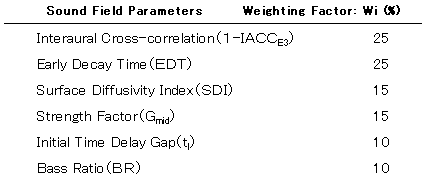 |
If a person consults the results of a quantitative analysis of how a room sounds, using, for example, each value in a list of a set of multiple parameters such as the list shown in the accompanying table, and the purpose of using the quantitative analysis is limited to assisting the person's evaluation process, then I see no problem with using quantitative analysis. An analogy to this use of the sound field parameters is the way that I use the results from a battery of some 30-odd tests I undergo as part of my annual physical exam. After the physical, I receive a sheet showing each test's result accompanied by a value or range of values for healthy individuals. I use this list of results to evaluate the state of my health. However, if I were to perform some calculation of all of the various tests' results so that I could plot a composite score along a single axis, and if, on this single axis, I created a ranking of my health as either superior or inferior, I would be making inappropriate use of these measurements. Surely, composite scoring is a methodology that has long been commonly used for evaluating many things. It is the way some schools decide who to admit and the way we often select one brand of merchandise over another, but that does not make it a good approach for evaluating everything.
In particular, the development and promotion of a methodology that uses a form of composite scoring to evaluate hall acoustics has been attracting attention and stirring up debate among project teams engaged in new hall planning. The proposed methodology assigns a weighting factor "Wi" to each of the sound field parameters "Si," and calculates a numeric value for each hall based on the sum of the weighted parameters. The calculated numeric value determines if the hall is ranked A+, A, B, C or lower. The accompanying chart shows the sound field parameters and their weighting that are used in the hall-raking calculations.
<< Dr. Beranek's Ranking and Hall Configuration >>
The key proponent of the weighting methodology is the American acoustician Dr. Leo Beranek, who, in the volume, "Music, Acoustics & Architecture," which he compiled, spells out this methodology. Dr. Beranek developed his methodology by using measurements of the acoustical characteristics of many halls around the world and by actually listening to concerts in these halls himself. After his first publication of the methodology, he continued his research and further defined and systematized his approach, culminating in his book, "Concert and Opera Halls, How They Sound," in which he documents and explains his methodology in detail.
According to Dr. Beranek's methodology, narrow-width "shoebox" configuration halls such as the Vienna Musikverein and Boston Symphony Hall have the ideal acoustics and a rank of "A+," while vineyard configuration halls, such as the Berlin Philharmonic Hall, are spaces that can only achieve a rank of "A," and are incapable of "A+" acoustics. However, as the excellent acoustical evaluations of Suntory Hall, Sapporo Concert Hall and, most recently, Walt Disney Concert Hall demonstrate, today, music fans and performers alike understand and appreciate that the acoustics of vineyard configuration halls are distinct from those of shoebox configuration halls and should be savored in their own right.
<< My Suggestion for the Concert Patrons >>
Fundamentally, concert halls' acoustics are like flavors to the sense of taste. These are both worlds in which personal "tastes" and preferences can take many directions and attempts to squeeze evaluations and judgments into a one-dimensional approach seem forced. The kind of people most likely to favor quantitative ranking are the members of construction-project committees and bureaucrats who have not personally experienced concert hall acoustics.
For concert hall patrons, assigning a rank of "A" or "B" to the halls they frequent can only diminish the sense of wonder they experience in the concert halls of their choice. Certainly, a person's enjoyment of concert halls may be deepened if the person learns about adequate acoustical attributes and how they combine to create the acoustics of a favorite seat in a favorite hall, or how they de-mystify why one hall sounds so different from another hall.
When advances and new approaches are developed in the field of acoustics, I think it is part of the mission of being an acoustical consultant to both understand the new ideas or methods, and to make sure that they are applied appropriately. Because concert halls can have many different personalities, and even the sound of one hall can change depending on the program performed in it, my advice to concert hall patrons is to please go to concerts and enjoy them for the performances without concerning yourself too much about what numerical values the hall has.
In current times, even in professional acoustical circles, there is a trend toward downplaying the importance of listening and experiencing, shutting our ears to the experiential phenomena that speak to us directly and authentically. Instead, we focus on the numerical results of measurements and outputs of calculations to make our decisions. I find this trend painful indeed.
E-mail Distribution of Nagata Acoustics News & Opinions
We hope you have enjoyed this News & Opinions newsletter, available each month on our web-site (http://www.nagata.co.jp). We also offer e-mail delivery of the text version of this newsletter. To receive the text newsletter to your e-mail address, simply send the following information to us at newsmail_e@nagata.co.jp:
(1) Your e-mail address
(2) Your name
(3) The name of your company
By requesting the text version via e-mail, you will automatically receive every newsletter and you can still get the visuals and graphics at our web-site.
Nagata Acoustics News 04-02 (No.194)
Issued : February 25, 2004
Nagata Acoustics Inc.
Hongo Segawa Bldg. 3F, 2-35-10
Hongo, Bunkyo-ku, Tokyo 113-0033 Japan
Tel: +81-3-5800-2671, Fax: +81-3-5800-2672
E-mail: info@nagata.co.jp







